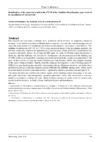Please use this identifier to cite or link to this item:
https://accedacris.ulpgc.es/jspui/handle/10553/114759
| Title: | Identification of the conserved motifs in the 5’UTR of the Ornithine Decarboxylase gene involved in reproduction of red seaweeds | Authors: | Montero Fernández, M. Robaina Romero, Rafael Juan García Jiménez, M. Del Pilar |
UNESCO Clasification: | 241707 Algología (ficología) 251001 Oceanografía biológica 251002 Oceanografía química |
Issue Date: | 2014 | Conference: | IV Congress of Marine Sciences | Abstract: | Red seaweeds are organisms commonly found worldwide which represent an important economical resource. As its relevance in the nourishment and nutraceutical industries has been increasing over the years, the employment of biotechnology for molecular investigation has became a powerful tool. The ornithine decarboxylase (OC, EC 4.1.1.17) is a key enzyme in charge of the polyamines synthesis that has been extensively related to the reproduction of red seaweeds, mainly involved in maturation of the cystocarps and spores release. By cloning the ODC gene, the study of different expression patterns in fertile and unfertile thalli has been favored. Furthermore, the characterization of the flanking area (5’UTR) of this gene would allow revealing those motifs involved in the up and down-expression of this gene. In this context, by using the inverse Polymerase Chain Reaction (iPCR), the complete structure of this gene is being elucidated. Initially, from the coding partial sequence, the 5 flanking region (5’ UTR) of this gene has been determined by chromosome walking. Moreover, conserved motifs have been identified according to different databases such as JASPAR Core, RBPDB, among others. These motifs have been mainly related to transcription factors regulated by ethylene, jasmonic acid and light. The characterization and identification of these regions allows obtaining a better knowledge of the complete gene ‘machinery’ and consequently, designing expression ‘vectors’ that incorporate in vitro new motifs to overexpress or silence the gene. These resulting cassettes or vectors could be used to study genetic transformations in multiple systems, both heterologous and homologous. | URI: | https://accedacris.ulpgc.es/handle/10553/114759 | ISBN: | 84-697-0471-0 | Source: | Book of Abstracts submitted to the IV Congress of Marine Sciences. Las Palmas de Gran Canaria, June 11th to 13th 2014, p. 259 |
| Appears in Collections: | Actas de congresos |
Page view(s)
70
checked on Nov 1, 2024
Download(s)
14
checked on Nov 1, 2024
Google ScholarTM
Check
Altmetric
Share
Export metadata
Items in accedaCRIS are protected by copyright, with all rights reserved, unless otherwise indicated.
